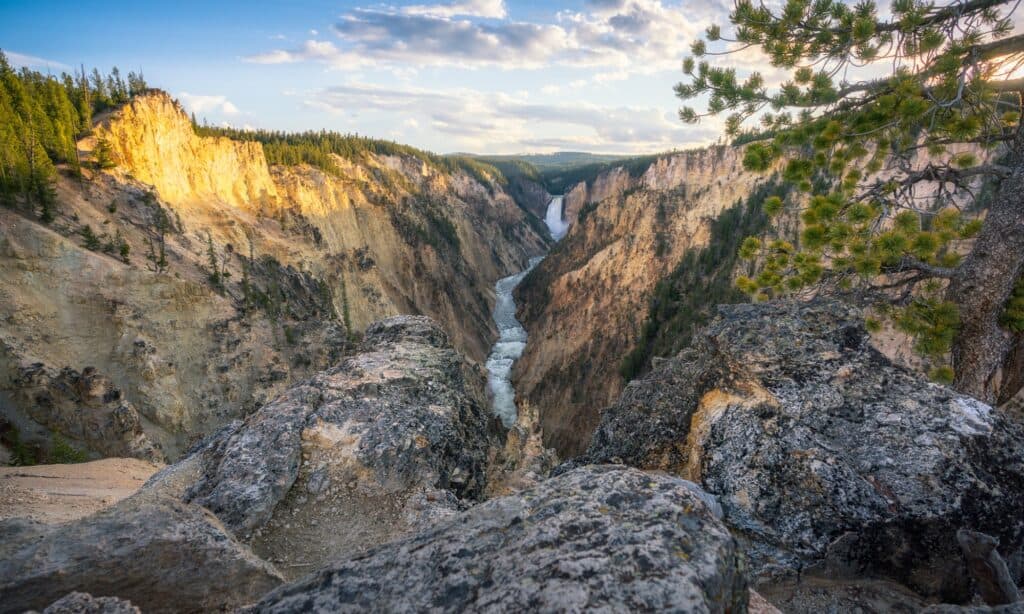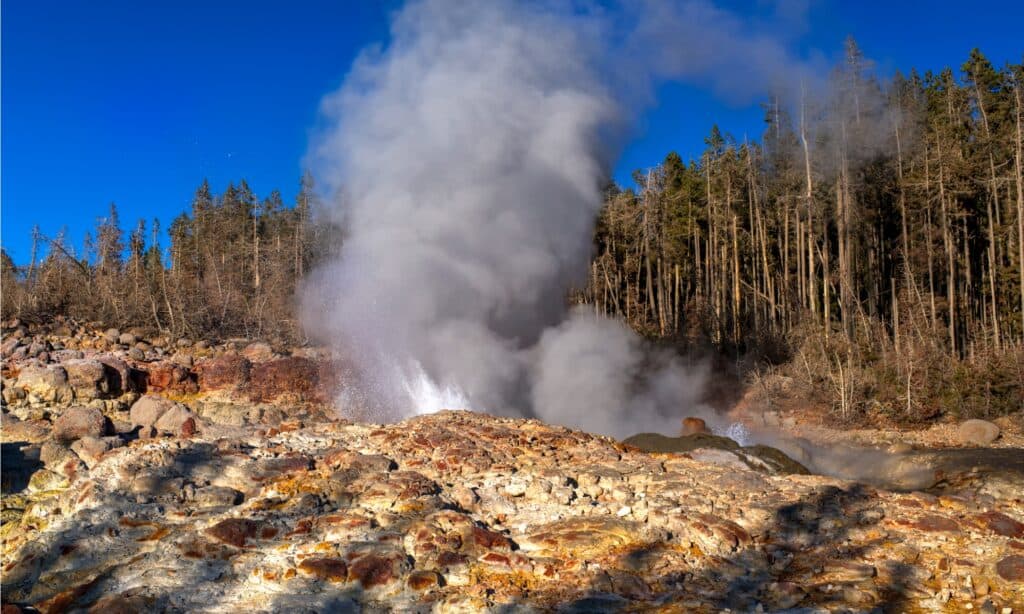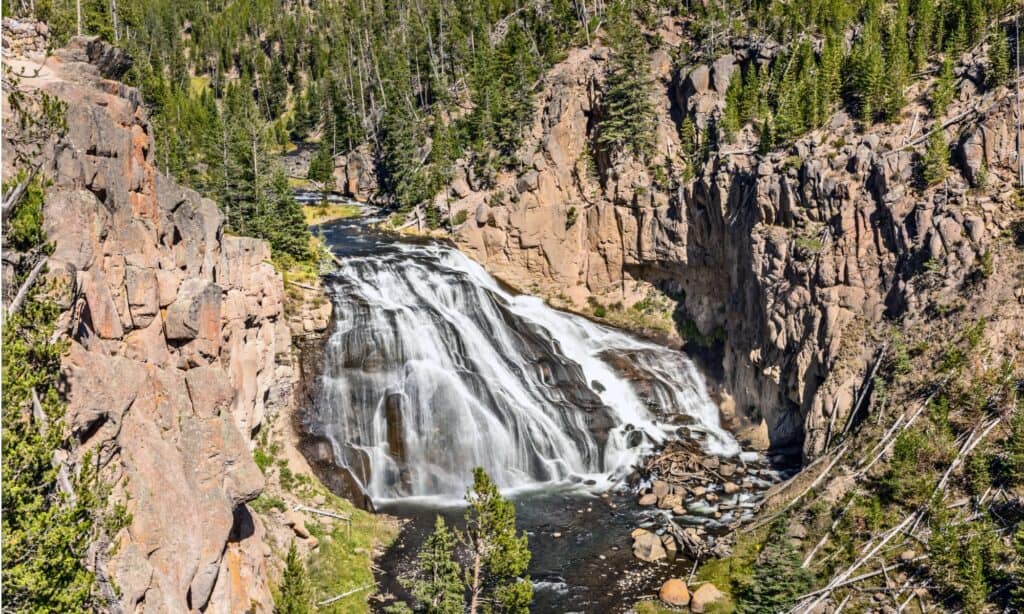Given just how large the previous eruptions have been from the Yellowstone supervolcano, you may be curious about the blast radius of Yellowstone should it erupt today. While many studies suggest that the Yellowstone Volcano is nowhere close to erupting and may not ever erupt again, there’s still an inherent curiosity to understand just how big this explosion might be.
In this article, we will go over everything you need to know about the Yellowstone blast radius, should this volcano ever decide to erupt. We will address just how far both lava and ash could potentially spread in the United States, and we will also go over the chances of the eruption happening in the first place. Let’s get started and talk all about volcanic activity in Yellowstone National Park now!
Yellowstone Blast Radius: Eruption Size

All volcanoes have a lifespan, and the Yellowstone Volcano is quite old in the grand scheme of things.
©iStock.com/ChrisB
There’s no completely accurate prediction as to how large the eruption size would be of the Yellowstone Volcano. Looking at past evidence, this supervolcano has the potential to erupt much larger than any other volcano in our recent history. For example, Mount Saint Helens erupted at a minuscule level compared to all three of the Yellowstone caldera eruptions.
Between the three huge eruptions that formed these three calderas within Yellowstone National Park, they produced over 900 cubic miles of debris and ash. To put things into perspective, Mount Saint Helens only produced only one-tenth of a cubic mile of debris and ash, even though it traveled around the world and covered much of the Midwest.
This isn’t to say that the Yellowstone Volcano will erupt in the same ways that it did millions of years ago. In fact, it is unlikely it will erupt at all, given the age of these calderas and lava flows. All volcanoes have a lifespan, and the Yellowstone Volcano is quite old in the grand scheme of things. For hypothetical curiosity only, let’s take a look at what might happen if the Yellowstone Volcano erupts!
Yellowstone Blast Radius: Lava and Magma Flows

When it comes to lava and magma flows spewing forth from this volcanic eruption, Yellowstone National Park would likely need to evacuate everyone within a 40 to 50 mile radius.
©iStock.com/SergeYatunin
Based on past research and the general location of the volcano itself, the blast radius of Yellowstone’s calderas is quite large. When it comes to lava and magma flows spewing forth from this volcanic eruption, Yellowstone National Park would likely need to evacuate everyone within a 40 to 50 mile radius.
Keep in mind that this evacuation order would go far beyond a 50-mile radius due to the amount of ash and debris that follows lava or magma substances. However, it is unlikely that the Yellowstone Volcano could produce lava that reaches beyond this radius. When you consider the fact that a 50-mile radius is still extremely large, it’s impressive to think about lava spreading that far!
Yellowstone Blast Radius: Ash and Debris

The Yellowstone Volcano would produce enough ash to cool the Earth’s temperature.
©iStock.com/BigshotD3
While the lava flows that follow a volcanic eruption sound terrifying on their own, the amount of ash and debris that could potentially be found in the Yellowstone blast radius is just as frightening. If the Yellowstone Volcano erupts in the same way that it did millions of years ago, the nearby states surrounding Yellowstone National Park would be decimated.
Wyoming, Colorado, Montana, and Idaho would likely all experience 3 to 4 feet of ash, and all at once. Besides these four states suffering the most damages, the entire United States would experience ash and debris to a certain extent, and even part of Canada would be affected. It is likely that 2-4 inches of ash would fall throughout the United States, and this is dangerous enough on its own.
Not only is the blast radius for ash and debris so large that it would halt nearly all transportation in the United States, but the type of ash produced by a volcanic eruption is very specific. The Yellowstone Volcano would produce enough ash to cool the Earth’s temperature. How exactly does this happen?
Volcanoes produce a type of sulfur or ash that reflects and absorbs sunlight. Essentially, this debris would enter the Earth’s atmosphere and cool the overall temperature of our planet, likely more than 1 to 2 degrees. While this may not sound like a big deal, this is enough to affect all outdoor grown agriculture, animals, and much more.
What are the Chances of the Yellowstone Volcano Erupting?

Many scientists claim that new volcanic activity in Yellowstone National Park will never result in an eruption again.
©iStock.com/Martina Birnbaum
Given the terrifying size of the Yellowstone Volcano blast radius, you may be wondering what the chances are of this volcano erupting in the first place. Thankfully, the chances of the Yellowstone Volcano erupting are very slim, if not nonexistent. Many scientists claim that new volcanic activity in Yellowstone National Park will never result in an eruption again.
But why is this? All volcanoes have a lifespan, and the Yellowstone calderas are no exception. The volcanic activity found beneath the surface of this National Park fuel geysers, hot springs, and much more, but there may not be enough juice left in the tank for a full-scale eruption. However, it is still an active volcano, so never say never! Just know that the Yellowstone Volcano will likely not erupt in our lifetime, or even for the next few hundred years.
The photo featured at the top of this post is © iStock.com/Teri Lee in Print
Thank you for reading! Have some feedback for us? Contact the AZ Animals editorial team.







